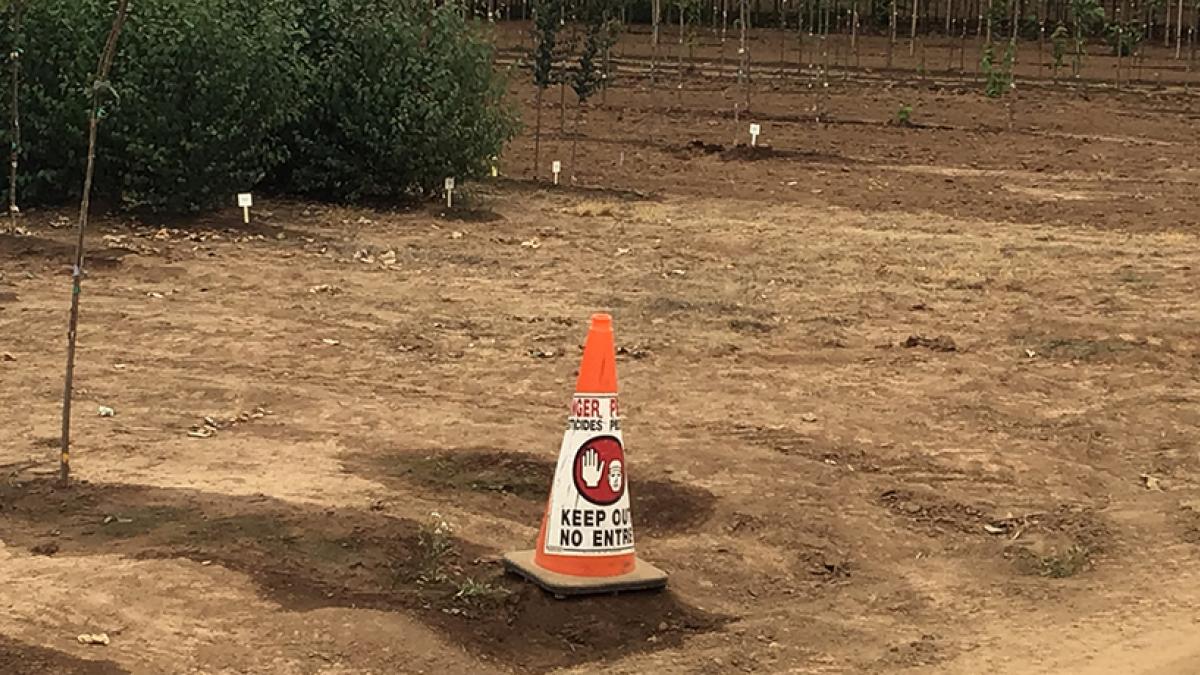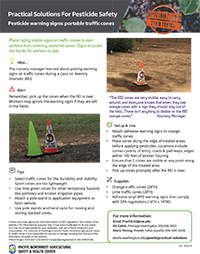
 Idea...
Idea...
The nursery manager learned about putting warning signs on traffic cones during a class on Reentry Intervals (REI).
drop-off and pickup.
 Alert
Alert
Remember, pick up the cones when the REI is over. Workers may start to ignore warning signs if they are left out.
 Setup & use
Setup & use
- Attach adhesive warning signs to orange traffic cones.
- Place cones along the edge of treated areas before applying pesticides. Locations include: entry corners points; roads & pathways; edges within 100 feet of worker housing.
- Ensure that at least two cones are visible at any point along the edge of the treated area.
- Pick up cones promptly after the REI is over.
 Supplies
Supplies
- Orange traffic cones (28”H)
- Lime traffic cones (28”H)
- Adhesive vinyl WPS warning signs that comply with EPA regulations (16”H x 14”W)
Left: lime green cones for other hazards
 Tips
Tips
- Select traffic cones for the durability and stability. Sport cones are too lightweight.
- Use lime green cones for other temporary hazards like potholes and broken irrigation pipes.
- Use pole stands and hand carts for moving and storing stacked cones.
- Attach a pole stand to application equipment or a farm vehicle to transport stacked cones to the field.
PERC Worker Protection Standard Guide
Pesticide Educational Resources Collaborative (PERC)
-
WPS Guide Posting Warning Signs
Worker Protection Standard
Federal
-
40 CFR 170.405a Entry restrictions associated with pesticide applications. (a) Outdoor production pesticide applications
-
40 CFR 170.407 Worker entry restrictions after pesticide applications
-
40C FR 70.409 Oral and posted notification of worker entry restrictions
Washington State (Washington Administrative Code)
-
WAC 16-233-111 Entry restriction associated with pesticide applications
-
WAC 16-233-116 Worker entry restrictions after pesticide applications
-
WAC-16-233-121 Oral and posted notification of worker entry restrictions
Oregon State (Oregon Administrative Rules)
-
OARs 437-004-6000, 170.1 - 170.260 Subdivision W, Worker Protection Standard
-
OAR 170.405 Entry restrictions associated with pesticide application
-
OAR 170.407 Worker entry restrictions after pesticide applications
-
OAR 170.409 Oral and posted notification of worker entry restrictions
We hope that you are inspired to use these solutions in your workplace. Did you try one of the practical solutions or develop a new one? We would appreciate hearing about your ideas and experiences.
Thank you and safe pesticide handling,
PNASH
Contact your state agency for more information on WPS regulations. The content of this website is for informational purposes only. It may need modification to fit your needs or it may not be appropriate for your workplace. Safe use of these solutions is your responsibility. The University of Washington and the Pacific Northwest Agricultural Safety & Health Center is not responsible for any loss or damage resulting from the use of the information provided on this website.
PNASH Project 2016-2021 (CDC/NIOSH Cooperative Agreement # U54 OH007544)
Contact us
Project Email:
PractSLN2@uw.edu
Project staff:
Maria Tchong-French (habla español)
Email: mitchong@uw.edu
206 685.6728

